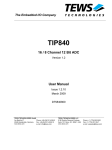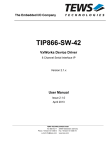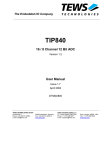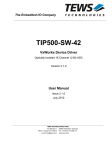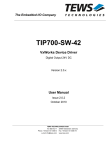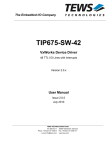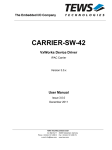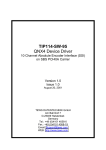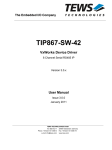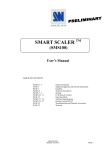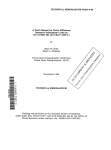Download TIP840-SW-42 - powerbridge.de
Transcript
The Embedded I/O Company TIP840-SW-42 VxWorks Device Driver 16 (8) Channel 12 bit A/D Version 2.0.x User Manual Issue 2.0.1 June 2008 TEWS TECHNOLOGIES GmbH Am Bahnhof 7 Phone: +49 (0) 4101 4058 0 25469 Halstenbek, Germany Fax: +49 (0) 4101 4058 19 www.tews.com e-mail: [email protected] TEWS TECHNOLOGIES LLC 9190 Double Diamond Parkway, Suite 127, Reno, NV 89521, USA www.tews.com Phone: +1 (775) 840 5830 Fax: +1 (775) 201 0347 e-mail: [email protected] TIP840-SW-42 This document contains information, which is proprietary to TEWS TECHNOLOGIES GmbH. Any reproduction without written permission is forbidden. VxWorks Device Driver 16 (8)Channel 12 bit A/D TEWS TECHNOLOGIES GmbH has made any effort to ensure that this manual is accurate and complete. However TEWS TECHNOLOGIES GmbH reserves the right to change the product described in this document at any time without notice. Supported Modules: TIP840 TEWS TECHNOLOGIES GmbH is not liable for any damage arising out of the application or use of the device described herein. 1996-2008 by TEWS TECHNOLOGIES GmbH Issue Description Date 1.0 First Issue May 1996 1.1 General Revision November 2003 2.0.0 IPAC Carrier Driver Support April 17, 2008 2.0.1 Carrier Driver description added June 24, 2008 TIP840-SW-42 – VxWorks Device Driver Page 2 of 22 Table of Contents 1 INTRODUCTION......................................................................................................... 4 1.1 Device Driver ...................................................................................................................................4 1.2 IPAC Carrier Driver .........................................................................................................................5 2 INSTALLATION.......................................................................................................... 6 2.1 Include device driver in Tornado IDE project ..............................................................................6 2.2 System resource requirement .......................................................................................................7 3 I/O SYSTEM FUNCTIONS.......................................................................................... 8 3.1 tip840Drv() .......................................................................................................................................8 3.2 tip840DevCreate()..........................................................................................................................10 4 I/O FUNCTIONS ....................................................................................................... 13 4.1 open() .............................................................................................................................................13 4.2 close().............................................................................................................................................15 4.3 ioctl() ..............................................................................................................................................17 4.3.1 FIO_TIP840_SETMODE....................................................................................................19 4.3.2 FIO_TIP840_SETGAIN......................................................................................................20 4.3.3 FIO_TIP840_READ_ADC ..................................................................................................21 TIP840-SW-42 – VxWorks Device Driver Page 3 of 22 1 Introduction 1.1 Device Driver The TIP840-SW-42 VxWorks device driver software allows the operation of the TIP840 IP conforming to the VxWorks I/O system specification. This includes a device-independent basic I/O interface with open(), close() and ioctl() functions. The TIP840-SW-42 driver includes the following functions: Reading ADC data (optional data correction with factory calibrated data) Programming gain for ADC channels Programming single or differential ADC Inputs The TIP840-SW-42 driver supports the modules listed below: TIP840-10 8 single-ended channel 12 bit ADC (gain 1, 10, 100) (IndustryPack ®) TIP840-11 8 single-ended channel 12 bit ADC (gain 1, 2, 4, 8) (IndustryPack ®) TIP840-20 16 single-ended / 8 differential channel 12 bit ADC (gain 1, 10, 100) (IndustryPack ®) TIP840-21 16 single-ended / 8 differential channel 12 bit ADC (gain 1, 2, 4, 8) (IndustryPack ®) To get more information about the features and use of the supported devices it is recommended to read the manuals listed below. TIP840 User manual TIP840 Engineering Manual CARRIER-SW-42 IPAC Carrier User Manual TIP840-SW-42 – VxWorks Device Driver Page 4 of 22 1.2 IPAC Carrier Driver IndustryPack (IPAC) carrier boards have different implementations of the system to IndustryPack bus bridge logic, different implementations of interrupt and error handling and so on. Also the different byte ordering (big-endian versus little-endian) of CPU boards will cause problems on accessing the IndustryPack I/O and memory spaces. To simplify the implementation of IPAC device drivers which work with any supported carrier board, TEWS TECHNOLOGIES has designed a so called Carrier Driver that hides all differences of different carrier boards under a well defined interface. The TEWS TECHNOLOGIES IPAC Carrier Driver CARRIER-SW-42 is part of this TIP840-SW-42 distribution. It is located in directory CARRIER-SW-42 on the corresponding distribution media. This IPAC Device Driver requires a properly installed IPAC Carrier Driver. Due to the design of the Carrier Driver, it is sufficient to install the IPAC Carrier Driver once, even if multiple IPAC Device Drivers are used. Please refer to the CARRIER-SW-65 User Manual for a detailed description how to install and setup the CARRIER-SW-42 device driver, and for a description of the TEWS TECHNOLOGIES IPAC Carrier Driver concept. How to use the carrier driver in the application program is shown in the programming example tip840exa.c. If the IPAC carrier driver isn’t used for the IPAC driver setup, the application software has to setup carrier board hardware, mapping of device memory and interrupt level setup by itself. TIP840-SW-42 – VxWorks Device Driver Page 5 of 22 2 Installation The following files and directories are located on the distribution media: Directory path ‘TIP840-SW-42’: tip840drv.c tip840def.h tip840.h tip840exa.c include/ipac_carrier.h TIP840-SW-42-2.0.1.pdf Release.txt ChangeLog.txt TIP840 device driver source TIP840 driver include file TIP840 include file for driver and application Example application Carrier driver interface definitions PDF copy of this manual Release information Release history 2.1 Include device driver in Tornado IDE project For Including the TIP840-SW-42 device driver into a Tornado IDE project follow the steps below: (1) Copy the files from the distribution media into a subdirectory in your project path. (For example: ./TIP840) (2) Add the device drivers C-files to your project. Make a right click to your project in the ‘Workspace’ window and use the ‘Add Files ...’ topic. A file select box appears, and the driver files can be selected. (3) Now the driver is included in the project and will be built with the project. For a more detailed description of the project facility please refer to your Tornado User’s Guide. TIP840-SW-42 – VxWorks Device Driver Page 6 of 22 2.2 System resource requirement The table gives an overview over the system resources that will be needed by the driver. Resource Driver requirement Devices requirement Memory < 1 KB < 1 KB Stack < 1 KB --- Semaphores --- 2 Memory and Stack usage may differ from system to system, depending on the used compiler and its setup. The following formula shows the way to calculate the common requirements of the driver and devices. <total requirement> = <driver requirement> + (<number of devices> * <device requirement>) The maximum usage of some resources is limited by adjustable parameters. If the application and driver exceed these limits, increase the according values in your project. TIP840-SW-42 – VxWorks Device Driver Page 7 of 22 3 I/O system functions This chapter describes the driver-level interface to the I/O system. The purpose of these functions is to install the driver in the I/O system, add and initialize devices. 3.1 tip840Drv() NAME tip840Drv() - installs the TIP840 driver in the I/O system SYNOPSIS #include “tip840.h” STATUS tip840Drv(void) DESCRIPTION This function initializes the TIP840 driver and installs it in the I/O system. The call of this function is the first thing the user has to do before adding any device to the system or performing any I/O request. EXAMPLE #include "tip840.h” /*------ Initialize Driver -----*/ status = tip840Drv(); if (status == ERROR) { /* Error handling */ } RETURNS OK, or ERROR if the function fails. TIP840-SW-42 – VxWorks Device Driver Page 8 of 22 ERROR CODES The error codes are stored in errno and can be read with the function errnoGet(). The error code is a standard error code set by the I/O system (see VxWorks Reference Manual). SEE ALSO VxWorks Programmer’s Guide: I/O System TIP840-SW-42 – VxWorks Device Driver Page 9 of 22 3.2 tip840DevCreate() NAME tip840DevCreate() – Add a TIP840 device to the VxWorks system SYNOPSIS #include “tip840.h” STATUS tip840DevCreate ( char *name, int devIdx, int funcType, void *pParam ) DESCRIPTION This routine adds the selected device to the VxWorks system. The device hardware will be setup and prepared for use. This function must be called before performing any I/O request to this device. PARAMETER name This string specifies the name of the device that will be used to identify the device, for example for open() calls. devIdx This index number specifies the TIP840 minor device number to add to the system. If modules of the same type are installed the device numbers will be assigned in the order the IPAC CARRIER ipFindDevice() function will find the devices. For TIP840 devices there is only one devIdx per hardware module starting with devIdx = 0. funcType This parameter is unused and should be set to 0. TIP840-SW-42 – VxWorks Device Driver Page 10 of 22 pParam This parameter points to a structure (TIP840_DEVCONFIG) containing the default configuration of the channel. The structure (TIP840_DEVCONFIG) has the following layout and is defined in tip840.h: typedef struct { struct ipac_resource *ipac; } TIP840_DEVCONFIG; ipac Pointer to TIP840 module resource descriptor, retrieved by CARRIER Driver ipFindDevice() function EXAMPLE #include "tip840.h” STATUS TIP840_DEVCONFIG struct ipac_resource result; tip840Conf; ipac; /* IPAC CARRIER Driver initialization */ /* ** Find an IP module from TEWS TECHNOLOGIES (manufacturer = 0xB3) ** with model number MODEL_TIP840 (see tip840.h). This module ** uses interrupts and we need only the IO space base address for the ** related driver. */ result = ipFindDevice(0xB3, MODEL_TIP840, 0, IPAC_INT0_EN | IPAC_LEVEL_SENS | IPAC_CLK_8MHZ, &ipac); if (result == OK) { devConfig.ipac = &ipac; /*------------------------------------------------------Create the device "/tip840/0" -------------------------------------------------------*/ tip840Conf.ipac = &ipac; … TIP840-SW-42 – VxWorks Device Driver Page 11 of 22 … result = tip840DevCreate( "/tip840/0", 0, 0, (void*)&tip840Conf); if (result == OK) { /* Device successfully created */ } else { /* Error occurred when creating the device */ } } else { printf("ERROR: No IP found on supported IP carrier boards\n"); } RETURNS OK, or ERROR if the function fails an error code will be stored in errno. ERROR CODES The error codes are stored in errno and can be read with the function errnoGet(). Error code Description S_ioLib_NO_DRIVER Driver not installed, run tip840Drv() S_tip840Drv_IARG Invalid argument in device configuration buffer. Please check all arguments given to tip840DevCreate(). S_ioLib_DEVICE_ERROR Device error. The certain TIP840 device seems to be faulty or isn’t a TIP840 device at all. EISCONN The Device has already been created. SEE ALSO VxWorks Programmer’s Guide: I/O System TIP840-SW-42 – VxWorks Device Driver Page 12 of 22 4 I/O Functions 4.1 open() NAME open() - open a device or file. SYNOPSIS int open ( const char *name, int flags, int mode ) DESCRIPTION Before I/O can be performed to the TIP840 device, a file descriptor must be opened by invoking the basic I/O function open(). PARAMETER name Specifies the device which shall be opened, the name specified in tip840DevCreate() must be used flags Not used mode Not used TIP840-SW-42 – VxWorks Device Driver Page 13 of 22 EXAMPLE int fd; /*-----------------------------------------Open the device named "/tip840/0" for I/O ------------------------------------------*/ fd = open("/tip840/0", 0, 0); if (fd == ERROR) { /* Handle error */ } RETURNS A device descriptor number, or ERROR if the function fails an error code will be stored in errno. ERROR CODES The error codes are stored in errno and can be read with the function errnoGet(). The error code is a standard error code set by the I/O system (see VxWorks Reference Manual). SEE ALSO ioLib, basic I/O routine - open() TIP840-SW-42 – VxWorks Device Driver Page 14 of 22 4.2 close() NAME close() – close a device or file SYNOPSIS int close ( int ) fd DESCRIPTION This function closes opened devices. PARAMETER fd This file descriptor specifies the device to be closed. The file descriptor has been returned by the open() function. EXAMPLE int int fd; retval; /*---------------close the device ----------------*/ retval = close(fd); if (retval == ERROR) { /* Handle error */ } RETURNS A device descriptor number or ERROR if the function fails an error code will be stored in errno. TIP840-SW-42 – VxWorks Device Driver Page 15 of 22 ERROR CODES The error codes are stored in errno and can be read with the function errnoGet(). The error code is a standard error code set by the I/O system (see VxWorks Reference Manual). SEE ALSO ioLib, basic I/O routine - close() TIP840-SW-42 – VxWorks Device Driver Page 16 of 22 4.3 ioctl() NAME ioctl() - performs an I/O control function. SYNOPSIS #include “tip840.h” int ioctl ( int int int ) fd, request, arg DESCRIPTION Special I/O operation that do not fit to the standard basic I/O calls will be performed by calling the ioctl function with a specific function code and an optional function dependent argument. For details of supported ioctl functions see VxWorks Reference Manual: VxWorks Programmer’s Guide: I/O system. PARAMETER fd This file descriptor specifies the device to be used. The file descriptor has been returned by the open() function. request This argument specifies the function that shall be executed. Following functions are defined: Function Description FIO_TIP840_SETMODE Set differential or single ended mode for AD conversion FIO_TIP840_SETGAIN Set gain for AD conversion FIO_TIP840_READ_ADC Read from an ADC channel arg This parameter depends on the selected function (request). How to use this parameter is described below with the function. TIP840-SW-42 – VxWorks Device Driver Page 17 of 22 RETURNS Function dependent value (described with the function) or ERROR if the function fails an error code will be stored in errno. ERROR CODES The error codes are stored in errno and can be read with the function errnoGet(). The error code is a standard error code set by the I/O system (see VxWorks Reference Manual). SEE ALSO ioLib, basic I/O routine - ioctl() TIP840-SW-42 – VxWorks Device Driver Page 18 of 22 4.3.1 FIO_TIP840_SETMODE NAME FIO_TIP840_SETMODE – Set differential or single ended mode AD conversion DESCRIPTION This function is used to define if the ADC input multiplexer shall be configured to 16 single-ended channels or to 8 differential channels. The function specific control parameter arg is a value describing the new AD conversion mode. Valid values for the ADC mode are: Value Description TIP840_SINGLE TIP840 ADC inputs are configured for single-ended channels. TIP840_DIFF TIP840 ADC inputs are configured for differential channels (not supported by TIP840-10/-11) EXAMPLE #include “tip840.h” int int status; fd; /*-------------------------------------------------Select single-ended input mode --------------------------------------------------*/ status = ioctl(fd, FIO_TIP840_SETMODE, TIP840_SINGLE); if (status == OK) { /* ioctl function successful */ } else { /* handle error */ } ERRORS S_tip840Drv_IMODE TIP840-SW-42 – VxWorks Device Driver Mode not supported. TIP840-10/-10 only supports single-ended mode. Page 19 of 22 4.3.2 FIO_TIP840_SETGAIN NAME FIO_TIP840_SETGAIN – Set gain for AD conversion DESCRIPTION This function is used to define the gain of the programmable amplifier for the ADC inputs. The selected gain value must be specified in the function dependent argument arg, as follows: Value Description TIP840_GAIN_1 Select Gain 1x Valid for TIP840-10/-11/-20/-21 TIP840_GAIN_10 Select Gain 10x Valid for TIP840-10/-20 TIP840_GAIN_100 Select Gain 100x Valid for TIP840-10/-20 TIP840_GAIN_2 Select Gain 2x Valid for TIP840-11/-21 TIP840_GAIN_4 Select Gain 4x Valid for TIP840-11/-21 TIP840_GAIN_8 Select Gain 8x Valid for TIP840-11/-21 EXAMPLE #include “tip840.h” int int status; fd; /*-------------------------------------------------Set gain 1 --------------------------------------------------*/ status = ioctl(fd, FIO_TIP840_SETGAIN, TIP840_GAIN_1); if (status == OK) { /* ioctl function successful */ } else { /* handle error */ } ERRORS S_tip840Drv_IARG TIP840-SW-42 – VxWorks Device Driver Invalid argument. TIP840-10/-20 only supports 3 different gain levels. Page 20 of 22 4.3.3 FIO_TIP840_READ_ADC NAME FIO_TIP840_READ_ADC – Read from a ADC channel DESCRIPTION The ioctl() function is used to read the value of a specified ADC channel. This function will use the ADC mode and gain which has been programmed with the last calls to the ioctl functions FIO_TIP840_SETMODE and FIO_TIP840_SETGAIN. The argument arg points to a driver-specific I/O parameter structure of type TIP840_ADC_BUFFER. typedef struct { unsigned int flags; unsigned int channel; int data; int timeout; } TIP840_ADC_BUFFER; flags If the ADC channel, specified by the parameter channel, has changed from a previous call of read, the data conversion will be automatically delayed until the settling time for the programmable gain amplifier has expired to get the best accuracy of the converted value. However this delay can be disabled by setting the flag TIP840_IGNORE. The flag TIP840_CORRECTION will enable the correction of the gain and offset error of the TIP840 with the factory calibration information which is stored in the ID PROM. All errors are considered to be linear. For each of the programmable gains two correction numbers are used. One corrects the offset (or zero) error, and the second corrects the gain error (see also Hardware User Manual, chapter “Data correction”). channel This parameter specifies the channel to convert. For TIP840-20/-21 in single ended mode, valid range is 1..16. For differential mode use range 1..8. For TIP840-10/-11, only channels 1..8 are valid. data If this ioctl() function succeeds this parameter receives the converted ADC channel data. timeout This parameter specifies the maximum time in system ticks the user is wiling to wait for ioctl completion. A value of -1 means “wait forever”, a value of 0 means “no wait” and a value greater than 0 means “wait timeout system ticks”. TIP840-SW-42 – VxWorks Device Driver Page 21 of 22 EXAMPLE #include “tip840.h” TIP840_ADC_BUFFER int STATUS int ADCbuf; fd; status; error; /*---------------------------------------------------------Start a conversion on ADC channel 1 and correct the result of the conversion by the factory calibration information ----------------------------------------------------------*/ ADCbuf.flags = TIP840_CORRECTION; ADCbuf.channel = 1; status = ioctl (fd, FIO_TIP840_READ_ADC, (int)&ADCbuf); if (status == ERROR) { printf(“Device read error errno = %xh\n”, errnoGet()); } else { printf(“ADC value = %d\n”, ADCbuf.data); } ERRORS S_tip840Drv_ICHAN Invalid ADC channel number. Check if module is configured to differential mode. S_tip840Drv_IARG The supplied pointer to the buffer is not valid. S_objLib_OBJ_TIMEOUT The conversion timed out, or another conversion pending. TIP840-SW-42 – VxWorks Device Driver Page 22 of 22






















